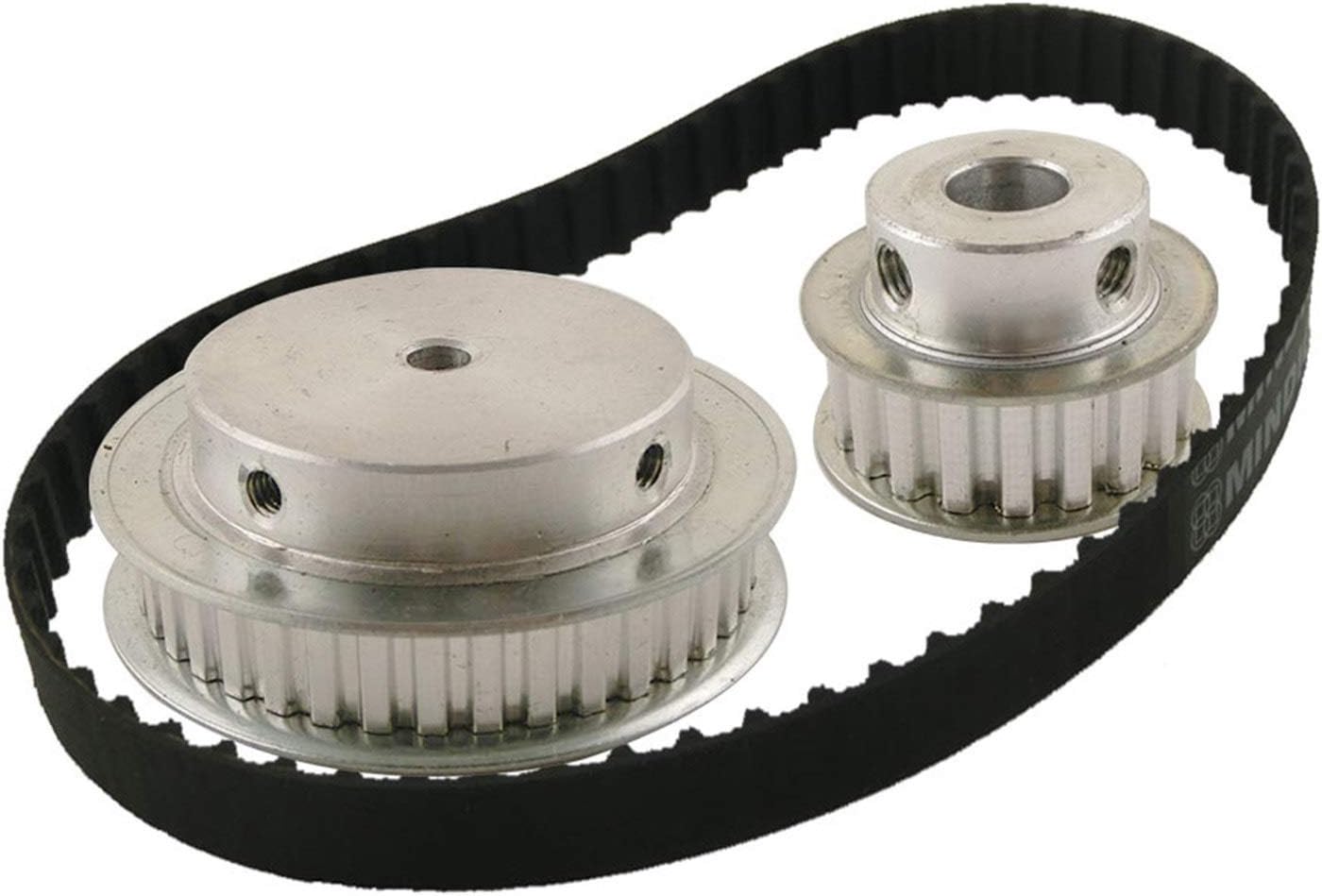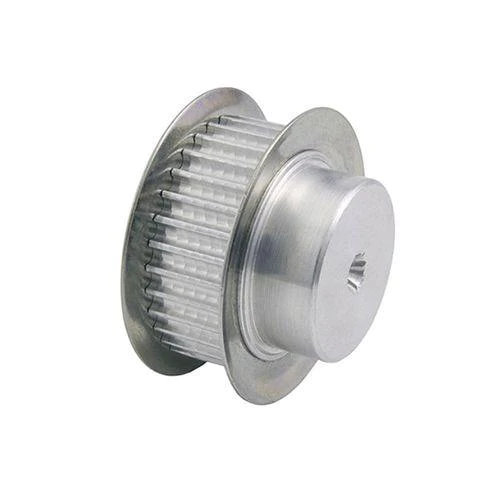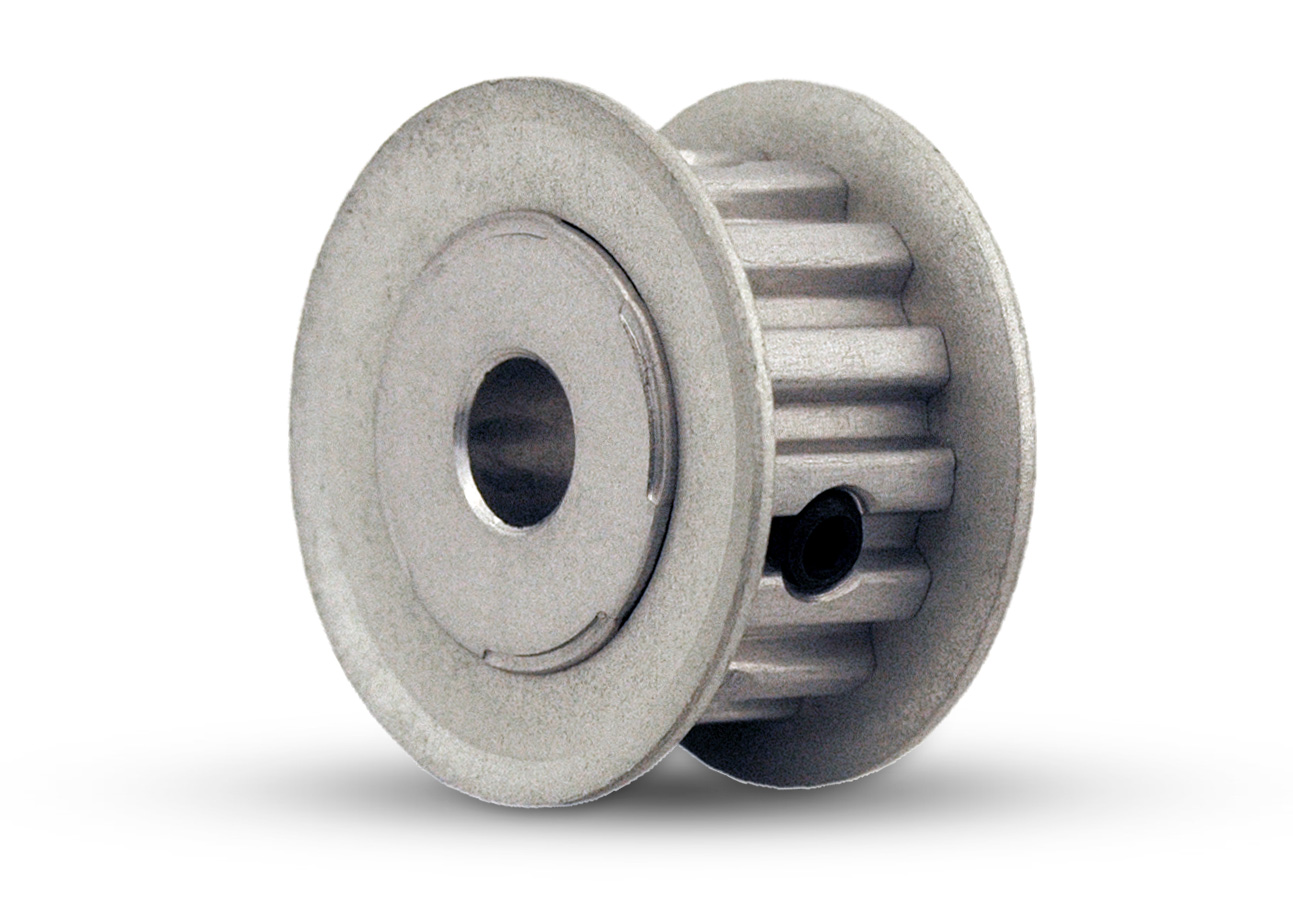Product Description
MXL XL Wholesale Price High Precision Aluminum Timing Pulley
Synchronous belt pulley transmission is composed of an annular belt with equidistant teeth on the inner peripheral surface and a belt pulley with corresponding teeth. During operation, the belt teeth mesh with the tooth slots of the belt pulley to transmit motion and power. It is a new belt transmission that integrates the respective advantages of belt transmission, chain transmission and gear transmission.
Product Parameters
Main Features:
1. OEM/ODM tooth number from 14 to 72 timing pulley
2. Material can be designed by customer requirement
3. High torque series S2M S3M S5M S8M P2M P3M P5M P8M
4. Normal torque series MXL XL L H
5. High precision drive series 2GT 3GT 5GT 8YU
6. Light load drive series T5 T10
7. Heave load drive series AT5 AT10
8. Clamping Timing Pulleys S3M S5M S8M
| Product | standard timing belt pulley & idler pulley |
| Customized | OEM, drawings or samples customized |
| Teeth type | Normal Torque Drive Type:MXL,XL,L,H,XH,XXH High Torque Drive Type:S2M,S3M,S5M,S8M,HTD2M,HTD3M,HTD5M,HTD8M,P2M,P3M,P5M,P8M High Precision Position Drive Type:2GT,3GT,5GT,8YU Light Load Drive Type:T5,T10,T20 Heavy Load Drive Type:AT5,AT10,AT20 |
| Basic shape | Type A,Type B,Type D,Type E,Type F,Type K |
| Adaption | Adapt to 1/4 inch,5/16 inch,1/2 inch, 3/8inch, 2/25inch, 1/5inch belt |
| surface treatment | Natural color anodizing,Black anodizing,Hard anodizing,Ni-plating,Blackening |
| Material | 6061(aluminum),S45C(45# steel),SUS304(Stainless steel) |
| Bore | Pilot bore, Taper bore and Customized bore. |
| Tolerance Control | Outer diameter ±0.005mm Length dimension ±0.05mm |
| Standard | DIN, ISO/GB, AGMA, JIS |
| Teeth Accuracy | DIN Class 4, ISO/GB Classs 4, AGMA Class 13, JIS Class 0 |
| Weight | Max 15Tons |
| testing equipment | projecting apparatus,salt spray test,durometer,and coating thickness tester,2D projector |
| producing equipment | CNC machine,automatic lathe machine,stamping machine,CNC milling machine,rolling machine,lasering,tag grinding machine etc. |
| Machining Process | Gear Hobbing, Gear Milling, Gear Shaping, Gear Broaching,Gear Shaving, Gear Grinding and Gear Lapping |
| Application industry | Robot industry,Medical industry,Making machine industry,Automation industry,3C industry equipment,Packaging industry,UAV industry,New energy industry. |
Company Profile
Packaging & Shipping
| lead time | 10-15 working days as usual,30days in busy season,it will based on the detailed order quantity |
| Delivery of samples | by DHL,Fedex,UPS,TNT,EMS |
FAQ
| Main Markets? | North America, South America, Eastern Europe , West Europe , North Europe, South Europe, Asia |
| How to order? | * You send us drawing or sample |
| * We carry through project assessment | |
| * We give you our design for your confirmation | |
| * We make the sample and send it to you after you confirmed our design | |
| * You confirm the sample then place an order and pay us 30% deposit | |
| * We start producing | |
| * When the goods is done, you pay us the balance after you confirmed pictures or tracking numbers. | |
| * Trade is done, thank you!! |
/* January 22, 2571 19:08:37 */!function(){function s(e,r){var a,o={};try{e&&e.split(“,”).forEach(function(e,t){e&&(a=e.match(/(.*?):(.*)$/))&&1
| Certification: | CE, ISO |
|---|---|
| Pulley Sizes: | Type A |
| Manufacturing Process: | Forging |
| Material: | Carbon Steel |
| Surface Treatment: | Oxygenation |
| Application: | Chemical Industry, Grain Transport, Mining Transport, Automation Equipment |
| Samples: |
US$ 10/Piece
1 Piece(Min.Order) | |
|---|
| Customization: |
Available
| Customized Request |
|---|

What is the significance of precision machining in XL pulley manufacturing?
Precision machining plays a crucial role in XL pulley manufacturing, offering several significant benefits. Here is a detailed explanation of the significance of precision machining in XL pulley manufacturing:
1. Accurate Dimensional Control:
Precision machining ensures accurate dimensional control in the manufacturing process of XL pulleys. The precise shaping and machining of the pulleys’ components, such as the hub, bore, and tooth profile, guarantee the correct fit and alignment with other components in the power transmission system. Accurate dimensional control results in smooth and efficient operation of the pulleys.
2. Consistent Tooth Profile:
Precision machining allows for the consistent production of the tooth profile on XL pulleys. The teeth on the pulleys must have precise shapes and dimensions to properly engage with the teeth of the timing belt, ensuring reliable power transmission. Consistency in tooth profile eliminates irregularities or variations that could lead to belt slippage, premature wear, or reduced system efficiency.
3. High Surface Quality:
Precision machining techniques produce XL pulleys with high surface quality. The smooth and polished surfaces of the pulleys reduce friction and wear, contributing to improved efficiency and prolonged belt life. High surface quality also minimizes noise, vibrations, and the risk of debris accumulation, ensuring smooth and reliable operation in various industrial applications.
4. Tight Tolerances:
Precision machining allows for the production of XL pulleys with tight tolerances. Tight tolerances ensure close adherence to specified dimensions and performance requirements. The precise alignment of pulley components, such as the bore and keyway, with the shaft guarantees a secure and accurate fit. Tight tolerances enhance the pulley’s overall performance, reliability, and compatibility with other system components.
5. Customization Capabilities:
Precision machining enables the customization of XL pulleys to meet specific application requirements. Manufacturers can easily modify the pulley’s design, dimensions, or features to tailor it for unique industrial needs. Precision machining techniques facilitate the production of custom pulleys with precise specifications, ensuring optimal performance and compatibility with the intended application.
6. Efficient Production Process:
Precision machining techniques, such as computer numerical control (CNC) machining, offer efficient and automated processes for XL pulley manufacturing. CNC machines can produce pulleys with high accuracy and repeatability, reducing human errors and ensuring consistent quality. The efficient production process enabled by precision machining results in cost-effective manufacturing, shorter lead times, and increased production capacity.
In summary, precision machining is of significant importance in XL pulley manufacturing due to its ability to achieve accurate dimensional control, consistent tooth profile, high surface quality, tight tolerances, customization capabilities, and efficient production processes. These factors contribute to the overall performance, reliability, and compatibility of XL pulleys in various industrial applications.

How does the size of an XL pulley impact its load-bearing capacity?
The size of an XL pulley plays a significant role in determining its load-bearing capacity. Here’s how the size of an XL pulley impacts its load-bearing capacity:
1. Surface Area:
The size of the pulley affects the surface area over which the force is distributed. Larger pulleys generally have a larger surface area, allowing for better force distribution and reducing the stress concentration on the pulley. This increased surface area helps in handling higher loads and reduces the risk of pulley failure.
2. Moment Arm:
The size of the pulley also affects the moment arm, which is the perpendicular distance from the center of the pulley to the line of action of the force. A larger pulley typically has a longer moment arm, resulting in a larger torque or moment applied to the pulley. This increased torque capacity allows the pulley to handle higher loads without experiencing excessive deflection or failure.
3. Tooth Engagement:
XL pulleys transmit power through the engagement of their teeth with the corresponding teeth on the timing belt. The size of the pulley determines the number of teeth and the contact area between the pulley and the belt. A larger pulley with more teeth provides increased contact area and better tooth engagement, resulting in improved load-bearing capacity and power transmission efficiency.
4. Material Strength:
The size of the pulley can also impact the selection of materials with appropriate strength properties. Larger pulleys may require materials with higher strength to withstand the increased loads. The choice of materials with adequate tensile strength, fatigue resistance, and durability becomes crucial in ensuring the load-bearing capacity of the pulley.
5. Speed and Torque:
The size of the pulley influences the speed and torque characteristics of the system. Larger pulleys can accommodate larger belts, resulting in increased belt contact surface and improved power transmission. This allows for higher torque transfer capabilities, enabling the pulley to handle heavier loads.
It’s important to note that while larger pulleys generally have higher load-bearing capacities, other factors such as material properties, design considerations, and proper installation also influence the overall load capacity of the pulley system. Therefore, it is essential to consult the manufacturer’s guidelines and engineering calculations to determine the appropriate pulley size and ensure safe operation under the desired load conditions.

In which applications and industries are XL pulleys commonly used?
XL pulleys find extensive use in various applications and industries that require precise motion control and power transmission. Here are some common applications and industries where XL pulleys are commonly employed:
1. Robotics:
XL pulleys are utilized in robotic systems for precise positioning and movement control of robot arms, grippers, and other robotic components. They enable accurate and synchronized motion, allowing robots to perform complex tasks with precision.
2. CNC Machines:
CNC (Computer Numerical Control) machines, such as milling machines and lathes, rely on XL pulleys for precise control of spindle speed and tool positioning. The accurate motion provided by XL pulleys ensures high-quality machining and dimensional accuracy in CNC operations.
3. 3D Printers:
XL pulleys are commonly used in 3D printers to control the movement of the print head and the positioning of the build platform. The precise motion control facilitated by XL pulleys contributes to the accuracy and fine detail of the printed objects.
4. Automated Systems:
XL pulleys are employed in various automated systems, including conveyor systems, packaging machinery, assembly lines, and material handling equipment. These systems require synchronized and precise motion to ensure efficient and accurate operation.
5. Industrial Machinery:
In industrial settings, XL pulleys are used in a wide range of machinery, such as textile machines, printing presses, woodworking equipment, and industrial automation systems. They provide reliable power transmission and motion control in these demanding applications.
6. Automotive Industry:
XL pulleys are utilized in automotive applications, including engine timing systems, accessory drives, and power steering systems. The precise control and synchronization offered by XL pulleys contribute to efficient and reliable operation of these automotive components.
7. Medical Devices:
In the medical field, XL pulleys are found in equipment such as diagnostic machines, laboratory automation systems, and surgical instruments. They enable accurate movement and positioning, ensuring the precision required for medical procedures and diagnostics.
8. Aerospace and Defense:
XL pulleys are used in aerospace and defense applications, such as satellite positioning systems, guidance systems, and unmanned aerial vehicles (UAVs). The reliable motion control provided by XL pulleys is crucial for the accurate operation of these aerospace and defense systems.
9. Research and Development:
In research and development laboratories, XL pulleys are employed in experimental setups, prototyping systems, and testing equipment. Their precise motion control capabilities support the development and validation of new technologies and products.
In summary, XL pulleys are commonly used in applications and industries that require precise motion control and power transmission. Their versatility and reliability make them suitable for a wide range of applications, from robotics and CNC machines to 3D printers, automated systems, automotive components, medical devices, aerospace, and research and development.


editor by CX
2024-05-08